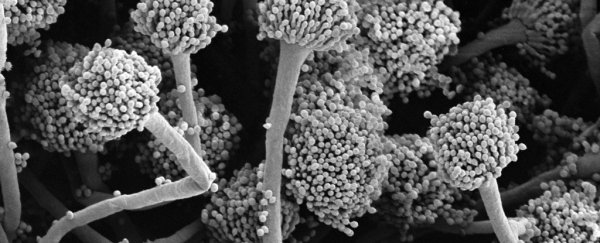Turns out fungus might be better suited for space travel than people are. New research has found that mould can survive incredibly high doses of ionising radiation, which means we may have to keep a very careful eye out for spores that might hitch a ride to Mars.
Blasted with radiation in a controlled setting, the two mould genera Aspergillus and Pennicillium were able to survive up to 200 times the fatal human dose of X-rays. This means they could survive radiation conditions on the outside of a spacecraft.
"We now know that [fungal spores] resist radiation much more than we thought they would, to the point where we need to take them into consideration when we are cleaning spacecraft, inside and outside," said microbiologist Marta Cortesão of the German Aerospace Centre (DLR).
"If we're planning a long-duration mission, we can plan on having these mold spores with us because probably they will survive the space travel."
Humans are pretty moist creatures. Put us in an enclosed box, and sooner or later the moisture from our sweat and breath is going to be running down the walls.
The International Space Station may be climate and humidity controlled, but it is still, indeed, an enclosed box - and there's enough damp that mould keeps growing on the walls. Aspergillus and Pennicillium are among the two most common space station invaders.
They can also cause some pretty nasty respiratory infections, when fungal filaments are breathed in and lodge themselves in the airways. Obviously, that's not ideal when you're orbiting 400 kilometres above Earth with limited medical supplies, not to even mention being en route to, say, Mars.
So these two mould genera seemed like pretty good candidates to blast with crazy amounts of ionising radiation and see what would happen.
The spores of the moulds were suspended in a saline solution, and Cortesão and her team deployed three kinds of radiation: X-rays, heavy ions, and high-frequency ultraviolet radiation that is stopped by Earth's atmosphere, but propagates freely in space.
The moulds survived incredibly high doses - 500 gray of heavy ions and 1,000 gray of X-rays. The gray is a unit of ionising radiation dose, defined as the absorption of one joule of radiation energy per kilogram of tissue.
Half a gray, delivered in one blast, is enough to give a person radiation sickness. And five gray is fatal to a human being.
The spores also survived 3,000 joules per metre squared of the ultraviolet radiation. So, given radiation alone, one ought to expect mould spores could survive a space trip, even to another planet.
But the research team hasn't yet tested other space conditions, such as vacuum and extreme temperature, although previous research conducted by researchers at DLR found that other organisms could survive those, housed in a special unit attached to the outside of the space station.
Similar research would need to be done to see if this applies to common mould spores as well, and whether we need to worry about, for example, contaminating the Moon next time we visit.
But mould in space wouldn't be all bad, the researchers note.
"Mould can be used to produce important things, compounds like antibiotics and vitamins," Cortesão said.
"It's not only bad, a human pathogen and a food spoiler, it also can be used to produce antibiotics or other things needed on long missions."
The team presented their research at the 2019 Astrobiology Science Conference.
